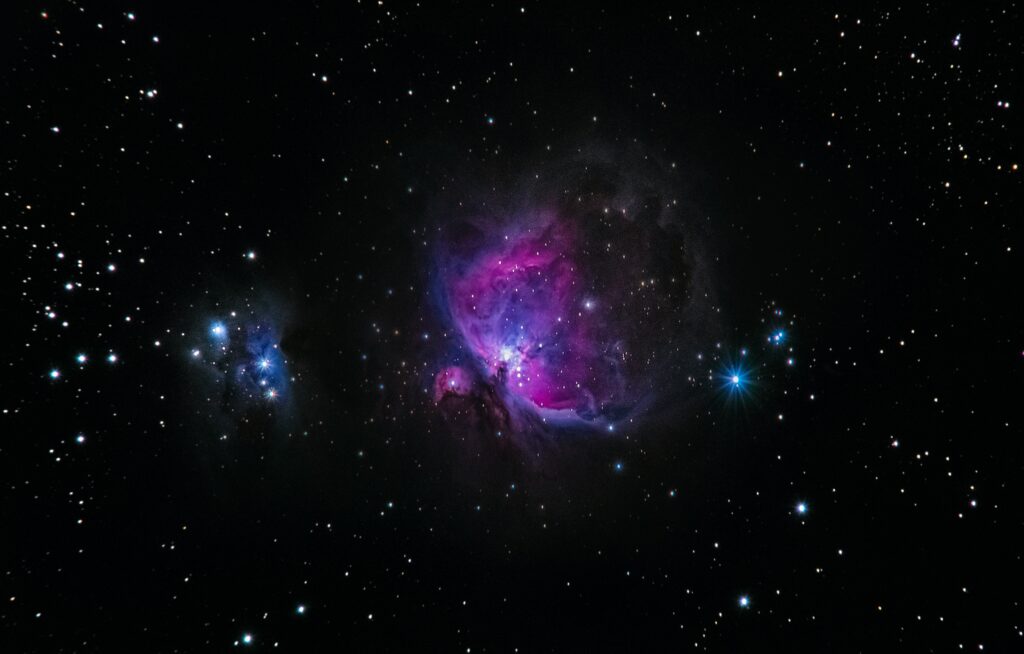Note: It’s been about a year since I started this website, but I just noticed a huge oversight: I haven’t gathered the non-Biblical evidence for God’s existence into a specific post yet 1. Now is the time to correct that oversight. A much fuller treatment of the topic can be found in the book “I Don’t Have Enough Faith to Be an Atheist” by Norman Geisler and Frank Turek. They are by no means the only ones to express these points, but this post owes a lot to their research, scholarship, and presentation.
Table of Contents
- In the Beginning….There WAS a Beginning.
- The Pieces Fit Together.
- It’s Alive!
- Here are the Blueprints.
- It’s Possible to be Wrong.
- If Not God, Then Who?
In the Beginning….There WAS a Beginning.
- Albert Einstein in 1916
- Willem de Sitter in 1917
- Arthur Eddington in 1919
- Edwin Hubble in 1927
What do these four people have in common? They brought us the “Big Bang” explanation of the universe (among many other accomplishments, and along with many other contributors to the scientific knowledge).
- Einstein formed the theory of General Relativity, which says that gravity can be explained as massive objects (stars and planets, for instance) causing space/time to curve around them.
- The common illustration is that if you set a bowling ball in the middle of a trampoline, the rubber sheet will bend down. Other objects will tend to spiral/slide in toward that depression. We see that slide as gravity, stronger or weaker depending on the weight of the ball and the resulting steepness of the depression.
- Eddington confirmed during a solar eclipse that the light from a distant star followed that curve around the sun, causing the star to appear to be in a different location than when seen in a normal night sky.
- de Sitter realized that General Relativity theory indicated that space/time could not only be “flexed” but also that it must be expanding.
- If you put several bowling balls of different sizes onto that trampoline, eventually they will all slide to the middle and form one lump. That the stars and planets haven’t all lumped together indicates that something else is acting to keep them separate: They are accelerating outward in all directions.
- Hubble found proof that objects throughout the universe really are moving away from one another; the universe really is expanding. The light we receive from distant objects changes wavelength depending on their distance and speed; the farther away they are, the faster they are accelerating.
But…
If the universe is expanding, then what was it like in the past? Everything was smaller and closer together, right? Well, then, what about even farther back? Still smaller and even closer. And way, way back? All squished together into a tiny ball. And before that? Nothing, pure nothing, not even space or time. It seems that the well-established theory of General Relativity also establishes that the universe had a beginning, before which it did not exist. That beginning came with an explosion of enough force that the shock waves are still rippling out, expanding the universe.
Why?
What could cause that tiny, incredibly dense, squished ball of matter — enough to make all the stars in all the galaxies, with all the planets orbiting them — to exist? What injected the power to explode that speck outward into a still-expanding universe? Something got it started, but what? Here are some characteristics that we can deduce about that “something”:
- Self-existent: It was there before there was anything else.
- Powerful: That was some explosion!
- Volitional: Bringing the squished matter into existence and exploding it must have been a choice, a deliberate act, so the “something” was capable of making decisions 2.
The Pieces Fit Together.
As the Big Bang exploded outward, the matter in the original squished ball was flung out in all directions. At that point, it wasn’t organized into “matter” yet; it was a disorganized mess of microscopic particles and radiation. Over time, it condensed down into atoms, then molecules, then stars and planets and galaxies and so on. Eventually, there was our Milky Way galaxy with its nucleus and spiral arms full of stars, our solar system located at a particular point along one of those arms, with its planets orbiting a sun, and a moon orbiting around our Earth.
To get to this point, a lot of factors had to come together. For instance, remember General Relativity, the way it causes gravity and is offset by the universe expansion? If those two weren’t balanced, too much gravity would make everything collapse back to a squished ball, or too much expansion would keep anything from condensing out to make planets. More specifically, Earth is a suitable place for us to live because of its…
- Location: Not too close to the Sun (hot!) or too far from it (Brrrr!) in a solar system not too close to the center of the galaxy (radiation) or too close to a spiral arm (too many super-novae exploding);
- Neighbors: The moon at the right size and distance to cause good tides, and also to keep the Earth on the right amount of tilt on its axis for seasons that vary but stay within an acceptable range of temperatures; Jupiter nearby with a lot of gravitational pull to catch meteors that would otherwise clobber us;
- Size: Big enough to have gravity to hold onto atmosphere, small enough to not be a meteor-magnet like Jupiter;
- Composition: A solid crust over a liquid-and-iron center that allows plate tectonics to cycle carbon and other elements, and to form a magnetic field to protect against solar radiation;
- Chemistry: Water; carbon; the right mix of oxygen, nitrogen, etc in the atmosphere;
- Cycles: Weather moving water from atmosphere to rivers/lakes/oceans and back; Tectonic activity moving continents, carbon, and other elements up from the core of the Earth and back down to be recycled.
There are many more factors that all come together to make the universe in general “work” and to make Earth, specifically, work for life to exist. Check out this article for more on 22 of these factors; the book “The Privileged Planet” gives even more, in extensive detail. And those factors all started in that initial exploding squished ball. How did that happen?
It seems that our starting “something” has the additional characteristics of incredible intelligence and organization!
It’s Alive!
Now that we have a universe that works, and a planet suitable for life, we can ask “How did life get started?”. We don’t have to talk about human life yet, though. We can start with any life. A single-celled life form, such as the ever-popular amoeba from our first biology class 3, for instance:
- Has a nucleus containing DNA that can have as many as 500 chromosomes (there is a lot of duplication);
- Is a predator, consuming other micro-organisms;
- Ingests food, digests it and uses the components, and excretes the leftovers;
- Moves by “flowing” via pseudopods, temporary extensions of the main cell that move as needed;
- Reproduces by splitting into two (or more) duplicates of itself.
All of that in one cell! How? Since all of these pieces have to interact properly in order for the cell to live, they couldn’t have evolved gradually. The first amoeba would not have made it to the second generation with only partly-working digestion or reproduction. 🙂 Michael Behe calls this “irreducible complexity“, the minimum functionality needed in order to survive.
And besides, where did the first one come from? All man-made attempts to take the right chemicals, give them the right environment, and end up with a living, reproducing organism have failed. Even if they succeed eventually, it would still just prove the point that it doesn’t happen by accident or at random.
Moving on from single-cell life, we build up complexity until we reach human life, with a huge variety along the way. But each of those millions of different life forms can be categorized both by what they have in common, and by how they differ. There is a clear organization to them, with each staying in its own “lane” 4. Fossil records show new species appearing and others going extinct, with both directions of movement being quite abrupt: Once a species appears, it stays pretty much as-is until it disappears. There may be subtle changes (think breeds of dogs 5 or resistant bacteria 6) but nothing dramatic.
Remember, all of this life (at least the potential for it) was embedded in that initial squished ball, so it has to trace back to that same “something”. Now we add that our “something” is capable of intricate design down to the molecular level within cells, as well as up to an incredible diversity of plants, insects, fish, birds, reptiles, amphibians, and mammals…each in their own place and time, and each suited for their environment (or in an environment suited to them, or both).
Here are the Blueprints.
SETI, the Search for Extraterrestrial Intelligence, scans the skies for any sign of intelligent alien communication. A major aspect of that is being able to recognize if a signal is actually communication, vs. naturally-occurring random noise. If the signal is Morse code that spells out “Take me to your leader”, then it is communication; if it is repetitive static, then it is not. Even in alien language or encryption code, a deliberate signal would stand out against all of the random ones.
Suppose someday a SETI researcher finds such a signal. At first, it’s a very simple message, the word “Lost”. But attached to that message are the blueprints of the missing spaceship, with a tag that says “Call BR549 if found”. The researcher would have to form two teams: one to call, and the other to build a spaceship!
Within each cell discussed above, from the amoeba through the millions of life forms (each made up of trillions of cells), are the blueprints for building another of those creatures. A strand of DNA would stretch out to as much as six feet in length, but is coiled up to fit inside one of the 23 chromosomes (for humans) … inside the nucleus … inside a cell that can only be seen with a microscope. Each strand contains the information required to build all of the protein “bricks” needed 7 and then assemble them into every structure of the entire body, the equivalent of multiple complete sets of encyclopedias. All of this information is written in a 4-letter chemical “alphabet” 8, with those four molecules sequenced together in words called “base pairs”. A DNA strand contains millions of these base pairs. DNA is such an efficient way of storing information that researchers are experimenting with the use of artificial DNA to store computer data!
If SETI were to find such an intricate, complex signal containing this much information, the lost-spaceship blueprints would pale into insignificance. Where did this information come from? It must be an intelligent communication from our starting “something”.
It’s Possible to be Wrong.
Once upon a time in a world far, far away named “Altmor”, children grew up wanting to be like their heroes. These included:
- Tom, the military commander who led the famous retreat in fear of a smaller unarmed force who said “Boo”;
- Mary, the teacher who failed the most students with the right test answers, and promoted the most with the wrong answers;
- David, the politician with the longest career where he never kept a single campaign promise;
- Deborah, the serial killer who had the most impressive number of victims, chosen specifically for their beauty and innocence;
- Michael, who had the most wives and managed to be totally unfaithful to all of them;
- Tammy, who had the largest collection of taxidermy-mounted kittens that she had tortured to death.
Other heroes embezzled money from investors, cheated everyone who ever trusted in them, and bragged about the number of women they had raped. Society honored them for these actions, and passed laws enforcing that others live up to them.
The little boys played “Tom”, “David”, and “Michael”; the girls played “Mary”, “Deborah”, and “Tammy”; and their parents smiled happily at the little darlings…before punishing the one child who tried to pet a kitten nicely and the other who tried to help one of “Deborah’s” victims.
Huh, what?!
Well, why not?
What’s wrong with Altmor? Who’s to say that it’s not better than a world where military heroes are brave, teachers are fair, politicians tell the truth, people respect life, husbands are faithful, and the innocent are protected? Isn’t everything just a matter of opinion, with no real standard of right and wrong? Or, if Altmor really is wrong, and things shouldn’t be like that, why not?
I submit that no one, of any nation or people group, at any time or place, would agree that Altmor’s values are good or right. Regardless of laws or habits or customs, everyone inherently knows that honesty is better than lies, courage is better than cowardice, and love is better than hate. (If anyone believes that they think otherwise — that Altmor is just fine — then they should consider their own reaction the last time that they were lied to or treated unfairly. Was it really just fine?)
The question becomes: “If everyone knows when the same something is wrong, how do they know that? What are they comparing against? What is their standard for “right”, and where did it come from?
Note: It is irrelevant what an individual actually does. They may act in ways that they know are wrong, and would not tolerate in others. Or, they may act in ways that Altmor would think are wrong, without being able to explain why they are honest and kind. That doesn’t change their standard, or explain where it comes from. It only says whether or not they are adhering to it.
If we continue the pattern we have going, then everything that exists comes from that “something” that caused the squished ball to explode. Up till now, we’ve been thinking about physical stuff like atoms, planets, and people. But what would be the source for non-physical stuff like standards of right and wrong? It looks like our starting “something” has moral standards 9, and has imparted those standards into the fabric of the universe.
If Not God, Then Who?
To recap what we’ve learned about the “something” that must be there, that caused the universe to come into existence, we’ve found these characteristics:
- Self-existence
- Power
- Volition
- Intelligence
- Organization
- Intricate Design
- Communication
- Moral Standards
From these characteristics, we can tell that we have a “Who” rather than a “What”. A “What” might have the self-existence and the power. But it would not be capable of volition, intelligence, design, communication, or moral standards. Those features require a “Who”.
Up to this point in this post, I have not quoted the Bible or referenced any concept from Christianity. But it would be rather difficult now to avoid pointing out that the God of the Bible does match all of these characteristics. Are there any other candidates for the position of “something”?
When introducing Himself to Moses in Exodus 3:13-14, God said “I AM WHO I AM”; He directed Moses to tell the people that “I AM” was the One who had sent him on his mission. In the same way, God points to the universe and simply says “I AM!!” 10 11
While this post focusses on some of the non-Biblical evidence, there is much more evidence of God’s existence and character. Just the fact that we humans are self-aware and search for meaning points to an in-built knowledge that we are connected to “something” beyond us. The fulfilled prophecies of the Bible, including those of God’s acts in history and of the promised Messiah, are as historical as any secular information we have from the ancient world (such as Socrates, Julius Caesar, and Alexander the Great). Especially, the historical evidence for the resurrection of Jesus has survived two millennia of critique, and still stands firm. God is!
Footnotes and Scripture References
- Although, an early post on Evolution came close.
- Otherwise, we would need “something else” to cause the “something” to act. That just backs the entire scene up another level. That way lies madness!
- See some fascinating descriptions and video here, here, here, and here.
- There are rare exceptions and confusing critters. But there is no plethora of bird-bugs or fish-frogs or dog-bears.
- Although, the wide variety of dog breeds required human intervention. They didn’t occur naturally.
- But even resistant, that bacteria still causes the same illness. A malaria germ doesn’t decide to start causing pneumonia, instead.
- from the raw-material molecules derived from food
- The four “nucleotide bases” are adenine (A), thymine (T), guanine (G) and cytosine (C).
- “Altmor” is a fictional place where “alternate morality” is in effect. It’s unthinkable as a real place, though, isn’t it?
- “The heavens declare the glory of God” (Psalm 19:1-2)
- “For since the creation of the world God’s invisible qualities—his eternal power and divine nature—have been clearly seen, being understood from what has been made…” (Romans 1:20)


